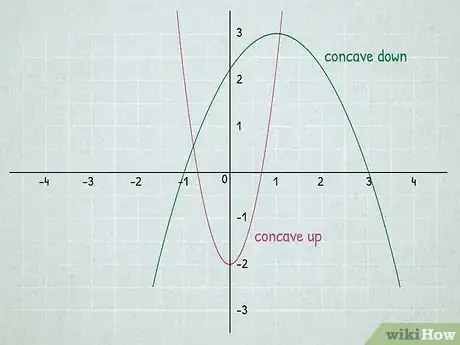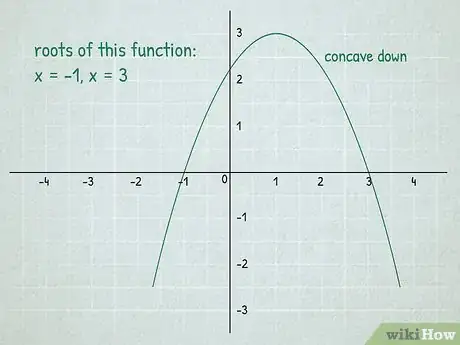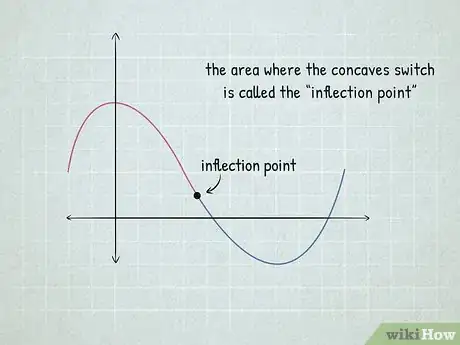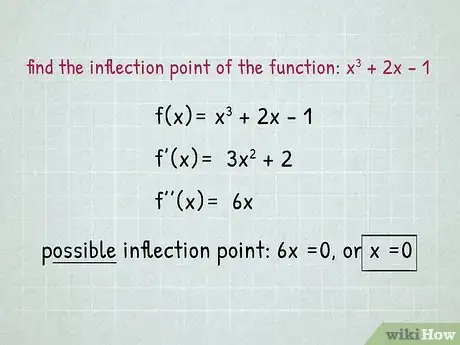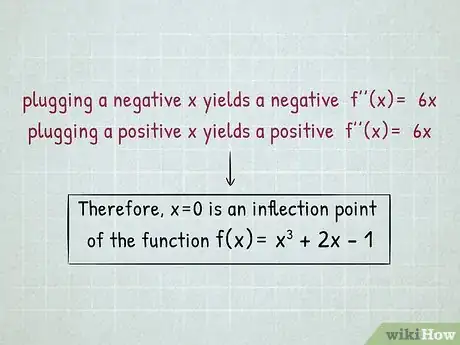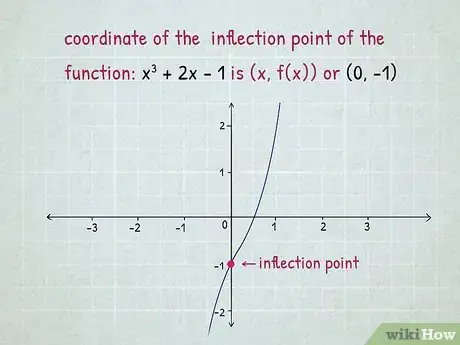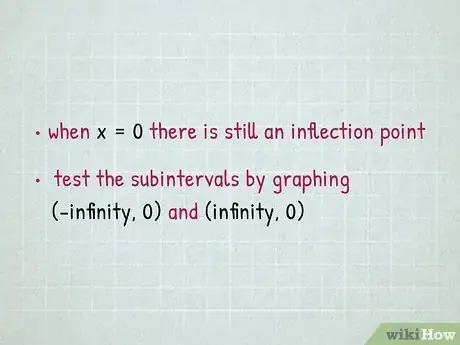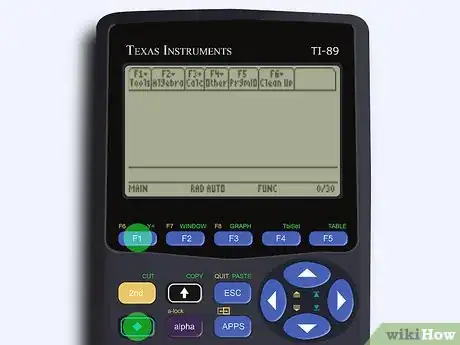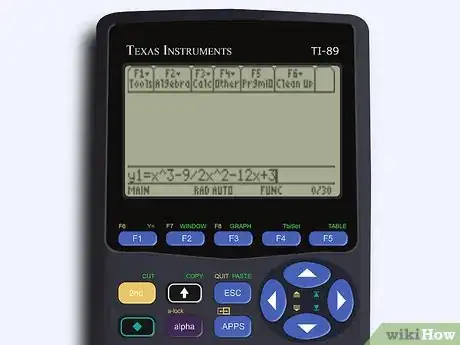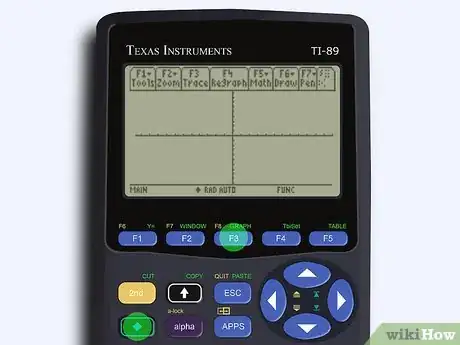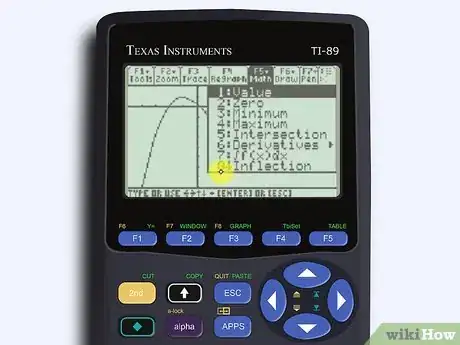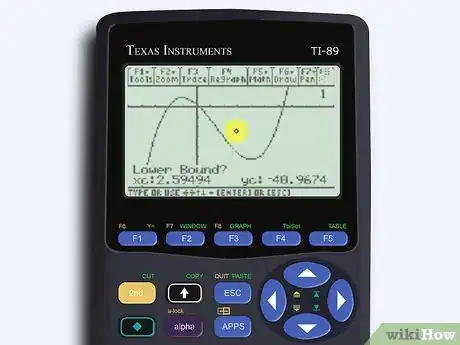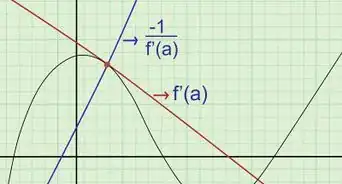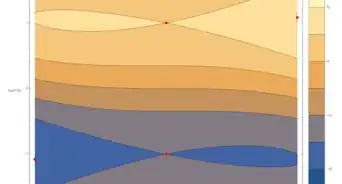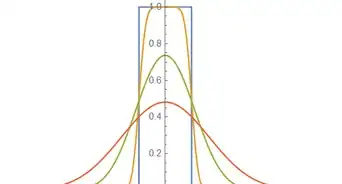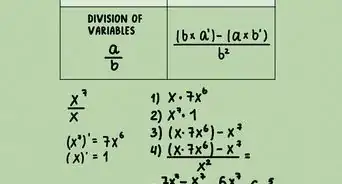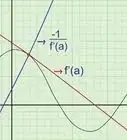This article was co-authored by wikiHow staff writer, Hannah Madden. Hannah Madden is a writer, editor, and artist currently living in Portland, Oregon. In 2018, she graduated from Portland State University with a B.S. in Environmental Studies. Hannah enjoys writing articles about conservation, sustainability, and eco-friendly products. When she isn’t writing, you can find Hannah working on hand embroidery projects and listening to music.
There are 13 references cited in this article, which can be found at the bottom of the page.
This article has been viewed 319,969 times.
Learn more...
In calculus, an inflection point is a point on a curve where the slope changes sign.[1] It is used in various disciplines, including engineering, economics, and statistics, to determine fundamental shifts in data. If you remember what concavity is and how it affects inflection, you’ll be able to find the inflection points of the curve with a few simple equations.
Steps
Reviewing Concavity and Inflection
-
1Differentiate between concave up and concave down. To understand inflection points, you need to distinguish between these two. They’re easy to distinguish based on their names.[2]
- A concave down function is a function where no line segment that joins 2 points on its graph ever goes above the graph. Intuitively, the graph is shaped like a hill.
- A concave up function, on the other hand, is a function where no line segment that joins 2 points on its graph ever goes below the graph. It is shaped like a U.
- In the graph above, the red curve is concave up, while the green curve is concave down.
- Functions in general have both concave up and concave down intervals. Inflection points exist when a function changes concavity.
-
2Identify the roots of a function. A root of a function is the point where the function equals zero. In the graph above, we can see that the roots of the green parabola are at and These are the points at which the function intersects the x-axis.[3]
- A function can also have more than 1 root.
Advertisement -
3Find inflection where the function changes concavity. Remember how there’s a difference between concave up and concave down? The area where the concaves switch is called the “inflection point,” which is what you’re trying to find.[4]
- It’s easy to see this point on a graph.
Finding the Derivatives of a Function
-
1Differentiate. Before you can find an inflection point, you’ll need to find derivatives of your function. The derivatives of the basic functions can be found in any calculus text; you’ll need to learn them before you can move on to more complex tasks.[5] First derivatives are denoted as or
- Say you need to find the inflection point of the function below.
- Use the power rule.
- Say you need to find the inflection point of the function below.
-
2Differentiate again. The second derivative is the derivative of the derivative, and is denoted as or
-
3Set the second derivative equal to 0, and solve the resulting equation. Your answer will be a possible inflection point. [6]
Finding an Inflection Point
-
1Check if the second derivative changes sign at the candidate point. If the sign of the second derivative changes as you pass through the candidate inflection point, then there exists an inflection point. If the sign does not change, then there exists no inflection point.[7]
- Remember that you are looking for sign changes, not evaluating the value. In more complicated expressions, substitution may be undesirable, but careful attention to signs often nets the answer much more quickly. For example, instead of evaluating numbers immediately, we could instead look at certain terms and judge them to be positive or negative.
- In our example, Then plugging a negative yields a negative while plugging a positive yields a positive Therefore, is an inflection point of the function There was no need to actually evaluate for our chosen values.
-
2Substitute it back into the original function.[8]
-
3Evaluate the function to find the inflection point. The coordinate of the inflection point is denoted as In this case, as graphed above. Therefore, those numbers are the inflection point.[9]
Troubleshooting
-
1Check the candidates. Often, when it is easy to assume that means there are no inflection points. However, when there is still an inflection point. Remember, 0 can be graphed, so if you get 0 as your answer, it means there is 1 inflection point.[10]
- For example, if you do get an answer where you would test the subintervals by graphing and . Therefore, the inflection point is at 0.
-
2Include points where the derivative is undefined. When you solve for an inflection point, you have to look for instances when the second derivative is 0 and when the second derivative is undefined. If you only look for ones where the second derivative is 0, chances are, you’ll get the wrong answer.[11]
- For example, if you were given the task of finding whether or not has an inflection point, you’d consider , NOT . This is because is the second derivative, while is the relative minimum point (which you aren’t looking for here).
-
3Analyze the second derivative, not the first one. When you’re finding inflection points, you should always be considering the second derivative. If you consider the first one, your answer will give you extremum points instead.[12]
- For example, if your possible inflection points are and you would test the x values at and This would tell you that your second derivative has inflection points at both AND
Using a Scientific Calculator
-
1Head to your “Plots.” On most scientific calculators, this will involve hitting the diamond or the second button, then clicking F1. This should take you to your Y plots where you can enter up to 7 values.[13]
- This is true on both the TI-84 and the TI-89, but it may not be the exact same on older models.
-
2Enter the function into y1. Clear out any remaining functions you had in your y plots, then type in the function after the equal sign into your calculator. Remember to keep any parentheses involved in the function so your answer is correct.[14]
- For example, the function might be
-
3Click “graph.” On most calculators, this will be “diamond” or “second,” then F3. If you have to adjust your window on the calculator, press “diamond” or “second,” then F2, then select “standard zoom.”[15]
- Don’t worry if your screen doesn’t show the whole graph just yet—you’ll be able to adjust it.
-
4Adjust the window until you can see the whole graph. When you open up the graphing window, you might not be able to see the entire curve of your graph. If that’s the case, click the “diamond” or “second” button, then open up F2 for zoom again. You can increase and decrease your minimum and maximum axis to figure out where your graph will fit inside of the window.[16]
- You might have to go back and adjust this a few times, as it can be hard to figure out where your graph is exactly.
-
5Click “Math,” then “Inflection.” Hit the “diamond” or “second” button, then select F5 to open up “Math.” In the dropdown menu, select the option that says “Inflection.”[17]
- This is—you guessed it—how to tell your calculator to calculate inflection points.
-
6Place the cursor on the lower and upper bound of the inflection. Your calculator will give you a message saying “Lower?” Move the arrows on your calculator until the cursor is to the left of the inflection point (you’ll have to know vaguely where it is on the graph). Then, your calculator will ask “Upper?” Move your cursor so it’s to the right of the inflection point, then hit “Enter.”[18]
- This is how you’ll get your calculator to make a guess as to where the inflection point is. Now you have your answer!
Community Q&A
-
QuestionWhat if the second derivative is a constant? How do I find the inflection point?
 Community AnswerInflection points are where the second derivative changes sign. If it is constant, it never changes sign, so there exists no inflection point for the function.
Community AnswerInflection points are where the second derivative changes sign. If it is constant, it never changes sign, so there exists no inflection point for the function. -
QuestionCan the first derivative become zero at an inflection point?
 OrangejewsCommunity AnswerYes, for example x^3. It changes concavity at x=0, and the first derivative is 0 there.
OrangejewsCommunity AnswerYes, for example x^3. It changes concavity at x=0, and the first derivative is 0 there. -
QuestionFind the value of x at which maximum and minimum values of y and points of inflection occur on the curve y = 12lnx+x^2-10x.
 Community AnswerTake the derivative and set it equal to zero, then solve. These are the candidate extrema. Take the second derivative and plug in your results. If it's positive, it's a min; if it's negative, it's a max. Set the second derivative to 0 and solve to find candidate inflection points. We can rule one of them out because of domain restrictions (ln x). Confirm the other by plugging in values around it and checking the sign of the second derivative.
Community AnswerTake the derivative and set it equal to zero, then solve. These are the candidate extrema. Take the second derivative and plug in your results. If it's positive, it's a min; if it's negative, it's a max. Set the second derivative to 0 and solve to find candidate inflection points. We can rule one of them out because of domain restrictions (ln x). Confirm the other by plugging in values around it and checking the sign of the second derivative.
References
- ↑ https://www.mathsisfun.com/calculus/inflection-points.html
- ↑ https://www.khanacademy.org/math/ap-calculus-ab/ab-diff-analytical-applications-new/ab-5-6b/a/concavity-review
- ↑ http://www.easy-math.net/root-of-a-function/
- ↑ https://www.youtube.com/watch?v=UK2shgCXALo&feature=youtu.be&t=65
- ↑ https://www.khanacademy.org/math/ap-calculus-ab/ab-diff-analytical-applications-new/ab-5-6a/v/inflection-points
- ↑ https://www.khanacademy.org/math/ap-calculus-ab/ab-diff-analytical-applications-new/ab-5-6b/a/inflection-points-review
- ↑ https://www.khanacademy.org/math/ap-calculus-ab/ab-diff-analytical-applications-new/ab-5-6b/a/review-analyzing-the-second-derivative-to-find-inflection-points
- ↑ https://www.mathsisfun.com/calculus/inflection-points.html
- ↑ https://www.khanacademy.org/math/ap-calculus-ab/ab-diff-analytical-applications-new/ab-5-6b/a/inflection-points-review
- ↑ https://www.khanacademy.org/math/ap-calculus-ab/ab-diff-analytical-applications-new/ab-5-6b/a/review-analyzing-the-second-derivative-to-find-inflection-points
- ↑ https://www.khanacademy.org/math/ap-calculus-ab/ab-diff-analytical-applications-new/ab-5-6b/a/review-analyzing-the-second-derivative-to-find-inflection-points
- ↑ https://www.math.ucdavis.edu/~kouba/CalcOneDIRECTORY/graphingdirectory/Graphing.html
- ↑ https://www.youtube.com/watch?v=OeD3_Es4J54&feature=youtu.be&t=15
- ↑ https://www.youtube.com/watch?v=OeD3_Es4J54&feature=youtu.be&t=32
- ↑ https://www.youtube.com/watch?v=OeD3_Es4J54&feature=youtu.be&t=32
- ↑ https://www.youtube.com/watch?v=OeD3_Es4J54&feature=youtu.be&t=81
- ↑ https://www.youtube.com/watch?v=IBqCV5WlwUY&feature=youtu.be&t=29
- ↑ https://www.youtube.com/watch?v=IBqCV5WlwUY&feature=youtu.be&t=46
About This Article
To find inflection points, start by differentiating your function to find the derivatives. Then, find the second derivative, or the derivative of the derivative, by differentiating again. To locate a possible inflection point, set the second derivative equal to zero, and solve the equation. Finally, find the inflection point by checking if the second derivative changes sign at the candidate point, and substitute back into the original function. For more tips on finding inflection points, like understanding concave up and down functions, read on!
